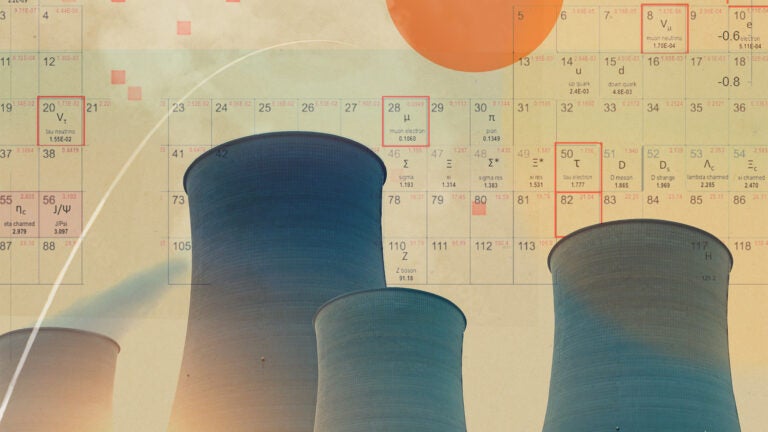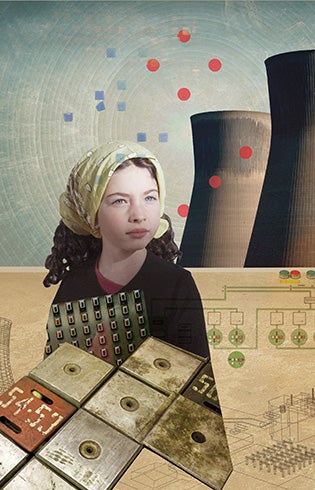
Nuclear Power as a Clean Energy Solution? The Debate Heats Up
 The United States is the world’s largest producer of nuclear energy, but for the last three decades, Americans’ primary exposure to nuclear power has arguably come not from scientific or political debate, but from its unflattering portrayal on a popular animated TV show. On the long-running satirical comedy series The Simpsons, the cooling towers of the fictitious Springfield Nuclear Power Plant are cracked, safety violations are rife, disposal of radioactive nuclear waste is haphazard at best, and the plant’s negligent safety director is none other than arch-bumbler Homer Simpson.
The United States is the world’s largest producer of nuclear energy, but for the last three decades, Americans’ primary exposure to nuclear power has arguably come not from scientific or political debate, but from its unflattering portrayal on a popular animated TV show. On the long-running satirical comedy series The Simpsons, the cooling towers of the fictitious Springfield Nuclear Power Plant are cracked, safety violations are rife, disposal of radioactive nuclear waste is haphazard at best, and the plant’s negligent safety director is none other than arch-bumbler Homer Simpson.
Whether this portrayal has influenced Americans’ opinions or simply reflected their worst fears is debatable. What we do know is that the Office of Nuclear Energy was sufficiently concerned about potentially negative fallout from
The Simpsons to release a statement in 2018 to clarify any misconceptions about nuclear safety possibly created by the show. The tone of the statement was humorous, but its message was clear: Stringent safety precautions and protocols in nuclear power plants are strictly enforced at all times.
Whatever impact The Simpsons may have had on public opinion in the past, perceptions of nuclear powerin the U.S. are rapidly improving. Increasingly touted as a potential clean energy solution in the battle against climate change, nuclear power is undergoing a renaissance in the U.S., with a growing number of leading environ-mentalists and powerful political figures from both sides of the aisle championing the energy source as a winning alternative to fossil fuels.
The burning question our leaders must answer is this: How can we stop burning fossil fuels to meet our climate goals while ensuring the power grid remains reliable? While serious concerns over its safety remain, could nuclear power be the answer? Our experts weigh the pros and cons.
America’s rocky road to nuclear acceptance
To understand America’s shifting relationship with nuclear power, it’s important to understand its historical evolution.
In 1953, in the aftermath of the bombing of Hiroshima and Nagasaki at the end of World War II and the controversial U.S. nuclear tests of the early 1950s, President Dwight D. Eisenhower delivered his “Atoms for Peace” speech advocating peaceful nuclear energy use. By 1954, with ample uranium to satisfy military needs, the U.S. concentrated on promoting peaceful nuclear applications. This led to a 1955 United Nations-sponsored international conference on nuclear power, creating the impetus for U.S. utilities to order more than 50 reactors to meet the country’s growing energy demands.
Indeed, officials with the U.S. Atomic Energy Commission, a government agency established after World War II to foster and control the development of atomic science and technology for peaceful purposes, had high hopes that 1,000 nuclear plants would be in operation by the year 2000.
Those hopes turned out to be short-lived as the National Environmental Policy Act of 1969 and the subsequent establishment of environmental agencies gave political clout to the growing lobby of anti-nuclear movements. All 41 reactors ordered after 1973 were canceled, according to the International Atomic Energy Agency (IAEA). By April 1976, Gallup reported that 60% of Americans opposed the construction of more plants.
“Much of the original opposition to nuclear energy wasn’t an objection to the technology itself, but a skepticism of authority that came out of the anti-war and civil rights movements,” says Jennifer Bernstein, a visiting scholar at the USC Dornsife College of Letters, Arts and Sciences’ Spatial Sciences Institute who tracks changing attitudes toward nuclear energy.
“Another major cause of opposition to nuclear power,” Bernstein says, “is a lack of understanding resulting from the fact that scientists have long failed to communicate information in a way that is accessible and relatable.”
Staring down the mouth of nuclear reactor

But perhaps the greatest barrier to the growth of nuclear power in the U.S. has been concern over safety in the wake of the near meltdown at Three Mile Island in Pennsylvania in 1979 and the nuclear disasters at Chernobyl, in what is now Ukraine, in 1986 and Fukushima, Japan, in 2011.
The accident at Three Mile Island led to increased opposition to new nuclear plants in the U.S. and halted their construction for almost 30 years. Two months after the accident at Chernobyl, opposition in the U.S. to expanding nuclear power plants rose to 73%, according to Gallup.
USC Dornsife’s Najmedin Meshkati is a nuclear expert who vividly remembers staring down the mouth of the Chernobyl nuclear power plant’s No. 3 reactor, clad only in a business suit. It was May 1997, 11 years after an accident triggered the nuclear disaster that transformed Chernobyl into a byword for human and environmental tragedy.
The professor of international relations at USC Dornsife, whose primary appointment is at the USC Viterbi School of Engineering where he is a professor of civil and environmental engineering, and industrial and systems engineering, had been invited by the plant’s general manager to inspect the facility.
As Meshkati surveyed the desolate landscape and heard the wind whistle through the deserted buildings, he realized the eeriness of the environment was matched only by the plant management’s complete disregard for his safety. This negligence, he concluded, might reflect something bigger: the lack of rigor that led to the accident.
“That was the moment,” he says, “that I realized the magnitude of the disaster.”
Fourteen years later, Meshkati — then a member of a National Academy of Sciences/National Research Council committee studying the lessons learned from the Fukushima nuclear accident — found himself in Japan inspecting the plant’s nuclear reactors just nine months after the earthquake and tsunami that triggered the disaster.
To his relief, he was provided with protective clothing prior to this plant visit and later scanned for radiation exposure.
Despite the improved safety protocols, the visit left an enduring impression. “Driving through the area was like driving through a ghost town,” Meshkati says of the experience, describing it as “one of the most transformative and sobering moments of my life.”
“Looking back, it always makes me think about the unthinkable.”
After inspecting Chernobyl and Fukushima, Meshkati, who emphasizes the importance of interdisciplinary research to ensure safety and well-being, is convinced that the biggest risks to nuclear power plants are human and organizational factors.
“Three Mile Island, Chernobyl and Fukushima — the common denominator for all three accidents was the poor safety culture leading to deficiencies in the system’s protective defenses,” he says.
Divided opinion
Over time, opinions about nuclear power in the U.S. have shifted. In 2010, Gallup found that 62% of Americans were in favor of nuclear energy — the highest level of support since the Three Mile Island accident. However, by 2012, a year after the Fukushima disaster, support had dipped to 57%. On balance, between 2004 and 2015, a majority of Americans (ranging from 52% to 67%) favored nuclear power due to increasing oil and gas prices. Nuclear energy was seen as a cost-effective alternative during this period. However, as gas prices declined, support for nuclear power also waned, dropping to 44% in 2016.
Much of the original opposition to nuclear energy wasn’t an objection to the technology itself, but a skepticism of authority that came out of the anti-war and civil rights movements.”
Other countries are much less divided than America on the issue of nuclear power. Sweden, Austria and Ireland stand firmly against it. China and India, however, have readily incorporated nuclear power as part of their energy mix, although the world’s two most populous nations generate a mere 3% to 5% of their electricity from nuclear reactors.
Many other nations welcome the use of nuclear power as a clean energy source. The most notable example is France, which derives 70% of its energy from nuclear power. The 1973 oil crisis nudged France toward energy independence, prompting the country to build 56 reactors during the ’80s and ’90s.
Russia’s invasion of Ukraine and its move to cut off European gas supplies gave countries such as Germany — which had begun phasing out nuclear power more than 20 years ago — pause for thought. As a result of Russia’s actions, Germany announced in September 2022 it would delay the closure of its remaining nuclear power plants until April 15, 2023, to ensure an independent energy supply. Despite opposition, Germany held to its deadline and began the process of shuttering its three remaining plants.
The announcement came the day before a meeting of G7 nations at which leaders of influential nuclear trade associations in the U.S., France, Canada, Japan and the United Kingdom announced they would work together to create independent supply chains for nuclear fuels that are not reliant on Russia.
Then there is Ukraine itself, which gets half its electricity from its 15 reactors at four plants. As the country struggles under severe Russian bombardment, the danger of a nuclear disaster weighs heavily on the beleaguered nation — and its neighbors.
Clearly, interest in nuclear power varies significantly among countries. Some are turning to nuclear power to provide energy independence and what they consider to be greener energy without the climate-heating emissions of fossil fuels. Others are wary of the dangers of nuclear waste disposal and the risk of nuclear disaster.
A new beginning?
As the world’s largest producer of nuclear power, the U.S. accounts for more than 30% of worldwide nuclear generation of electricity. Its 92 nuclear reactors across 52 facilities currently generate 20% of the country’s energy supply. However, only one of these plants was built in the last 25 years, reflecting enduring concerns over cost and safety.
Nuclear plants will need meticulous design and disciplined construction, operation and monitoring.”
But as climate change and the war in Ukraine pose energy challenges, coupled with higher oil prices, the popularity of nuclear power is rising once again in the U.S. following its 2016 dip. According to a 2022 Gallup survey, just over half of Americans are now in favor.
“Democrats and environmental organizations that have previously opposed nuclear are increasingly acknowledging its potential,” says Monica Dean, climate and sustainability practice director of USC Dornsife’s Public Exchange. President Biden’s $1.2 trillion Infrastructure Investment and Jobs Act includes significant funding for nuclear facilities.
Fear of power outages and the desire for energy security and reliability have already turned the tide in California, where the state legislature decided in September 2022 to keep the Diablo Canyon nuclear power plant in San Luis Obispo running for five years or more past its scheduled closure date.
But while support for nuclear power is growing, Dean says “the challenge for its proponents is that you still have entire generations, traumatized by nuclear accidents, who don’t see it as the most desirable option.”
A double-edged sword
Decarbonization and energy reliability and independence have created opportunities for new nuclear technology, including small module reactors (SMRs). “These reactors can be mass-produced, shipped in pieces, and assembled on-site for better quality control,” Meshkati says.
“However,” he cautions, “we haven’t seen all the risks yet.”
Anna Weichselbraun, a USC Berggruen Fellow and anthropologist based at USC Dornsife, is also concerned. Unlike large industrial reactors, the construction of SMRs can be difficult to track with satellites. Weichselbraun points out this will make it harder for the IAEA to track their movement and prevent their use in the construction of nuclear weapons.
Safety is paramount

Another key concern is the storage of nuclear waste, which can remain radioactive for tens of thousands, or even millions, of years.
Currently, the U.S. does not have any nationally designated long-term storage for high-level radioactive waste from its commercial nuclear power plants. Public and political opposition closed the nation’s proposed high-level nuclear waste disposal site, located in Yucca Mountain, Nevada, in 2009. Each plant must now store its waste on-site in dry casks.
“It is our collective, societal obligation to deal with nuclear waste management,” says Vincent Ialenti, a former USC Berggruen Fellow and a social anthropologist. An expert on Finnish culture, Ialenti found that Finland’s high level of trust in the competency of its government agencies, domestic engineers, civil servants and scientists allowed it to secure public support for constructing what may become the first deep-geologic repository for disposing of spent nuclear fuel from commercial power plants in operation anywhere in the world. It should be noted that there are repositories for low- and intermediate-level radioactive waste.
In the U.S., Ialenti says, that trust component is missing. Dean agrees.
“What we need are education efforts to help build trust and support for the advancements in technology, like SMRs, that offer significant safety advantages,” she says. “Until that happens, nuclear will continue to be held back by the same question: It failed before — why should anyone trust it now?”
That question also extends to how and where nuclear plants are constructed. John Vidale, Dean’s Professor of Earth Sciencesand former director of the Southern California Earthquake Center, based at USC Dornsife, notes that seismic issues pose a multifaceted risk.
“Even though the motion in future earthquakes can now be probabilistically estimated and factored into construction, so many engineered structures have failed in unexpected ways,” Vidale says. “Nuclear plants will need meticulous design and disciplined construction, operation and monitoring.”
Is diversity the answer?
So, what is the future of nuclear power in the U.S.? Although safety concerns persist, recent cost reductions and advances in technology and waste storage, coupled with the introduction of climate-change funding and a shifting global landscape, have collectively contributed to the growing appeal of nuclear power as a clean, safe and independent energy source.
Renewables, however, like solar and wind, are giving nuclear power a run for its money. Nuclear power costs between 5 cents and 15 cents per kilowatt-hour (kWh), while according to the International Renewable Energy Agency, the global average cost of solar and wind in 2020 was around 5 cents per kWh.
That’s a significant saving. However, the reliability of wind and solar is constrained by fluctuating power output due to weather patterns and daily availability of sunlight. Dean emphasizes that achieving the ambitious climate targets set around the world — such as the Biden administration’s goal of 80% renewable energy by 2030 and 100% carbon-free by 2035 — requires the deployment of carbon-free energy solutions. These solutions also need to be available now and capable of generating dependable power to consistently meet demand. Nuclear power ticks all these boxes.
Dean underscored her statement by pointing out that, according to the International Energy Agency, in 2022, the decline in nuclear power generation due to both maintenance and continued phaseouts led to an increase in carbon emissions. “Removing nuclear energy from the renewable energy mix is actually hurting our efforts at limiting warming,” Dean says.
Bernstein, the visiting scholar who tracks changing attitudes regarding nuclear energy, believes that people may accept some level of risk associated with nuclear power if it provides clean and reliable energy. “It’s a trade-off that many people may find acceptable,” she says. “Let’s not forget, emissions from tailpipes are killing people every day. Nuclear energy is not.”